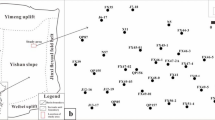Abstract
The environment of major sediments of eastern China oilfields is a meandering river where mud drapes inside point bar sand occur and are recognized as important factors for underground fluid flow and distribution of the remaining oil. The present detailed architectural analysis, and the related mud drapes’ modeling inside a point bar, is practical work to enhance oil recovery. This paper illustrates a new stochastic modeling of mud drapes inside point bars. The method is a hierarchical strategy and composed of three nested steps. Firstly, the model of meandering channel bodies is established using the Fluvsim method. Each channel centerline obtained from the Fluvsim is preserved for the next simulation. Secondly, the curvature ratios of each meandering river at various positions are calculated to determine the occurrence of each point bar. The abandoned channel is used to characterize the geometry of each defined point bar. Finally, mud drapes inside each point bar are predicted through random sampling of various parameters, such as number, horizontal intervals, dip angle, and extended distance of mud drapes. A dataset, collected from a reservoir in the Shengli oilfield of China, was used to illustrate the mud drapes’ building procedure proposed in this paper. The results show that the inner architectural elements of the meandering river are depicted fairly well in the model. More importantly, the high prediction precision from the cross validation of five drilled wells shows the practical value and significance of the proposed method.










Similar content being viewed by others
References
Bridge, J. S. (2006). Fluvial facies models: Recent developments. In R. G. Posamentier Walker (Ed.), Facies models revisited (Vol. 84, pp. 85–170). SEPM (Society for Sedimentary Geology) Special Publication. Tulsa, OK: SEPM.
Deutsch, C. V., & Tran, T. (2002). FLUVSIM: A program for object-based stochastic modeling of fluvial depositional systems. Computers & Geosciences, 28, 525–535.
Deutsch, C. V., & Wang, L. (1996). Hierarchical object-based stochastic modeling of fluvial reservoirs. Mathematical Geology, 28, 857–880.
Fabuel-Perez, I., Hodgetts, D., & Redfern, J. (2009). A new approach for outcrop characterization and geostatistical analysis of a low-sinuosity fluvial-dominated succession using digital outcrop models: Upper Triassic Oukaimeden Sandstone Formation, Central High Atlas, Morocco. AAPG Bulletin, 93, 795–827.
Fabuel-Perez, I., Hodgetts, D., & Redfern, J. (2010). Integration of digital outcrop models (DOMs) and high resolution sedimentology—Workflow and implications for geological modelling: Oukaimeden Sandstone Formation, High Atlas (Morocco). Petroleum Geoscience, 16, 133–154.
Gibling, M. R. (2006). Width and thickness of fluvial channel bodies and valley fills in the geological record: A literature compilation and classification. Journal of Sedimentary Research, 76, 731–770.
Jiao, Y., Lu, Z., Zhang, X., & Yang, S. (1997). Dynamical process and genesis of late triassic sediment filling in Ordos basin. Journal of China University of Geosciences, 8, 45–48.
Kolla, V., Posamentier, H. W., & Wood, L. J. (2007). Deep-water and fluvial sinuous channel: Characteristics, similarities and dissimilarities, and modes of formation. Marine and Petroleum Geology, 24, 388–405.
Leeder, M. R. (1973). Fluviatile fining upwards cycles and the magnitude of paleochannels. Geological Magazine, 110, 265–276.
Li, H., & Caers, J. (2007). Hierarchic modeling and history matching of multiscale flow barriers in channelized reservoirs. In 2007 SPE Annual Technical Conference and Exhibition (pp. 11–14), Anaheim, CA, Nov 2007. SPE 109252.
Li, H., & White, C. D. (2003). Geostatistical models for shales in distributary channel point bars (Ferron Sandstone, Utah): From ground-penetrating radar data to three-dimensional flow modeling. AAPG Bulletin, 87, 1851–1868.
Lopez, S., Galli, A., & Cojan, I. (2001). Fluvial meandering channelized reservoirs: A stochastic and process-based approach. In Proceedings Annual Conference of the International Association of Mathematical Geologists. International Association of Mathematical Geologists, Cancun, CD-ROM.
Marinus, E. D., & Irina, O. (2008). Connectivity of fluvial point-bar deposits: An example from the Miocene Huesca fluvial fan, Ebro Basin, Spain. AAPG Bulletin, 92, 1109–1129.
Miall, A. D. (1996). The geology of fluvial deposits. New York: Springer.
Pranter, M. J., Ellison, A. I., Cole, R. D., & Patterson, P. E. (2007). Analysis and modeling of intermediate-scale reservoir heterogeneity based on a fluvial point-bar outcrop analog, Williams Fork Formation, Piceance Basin, Colorado. AAPG Bulletin, 91, 1025–1051.
Pyrcz, M. J., Boisvert, J. B., & Deutsch, C. V. (2009). A library of training images for fluvial and deepwater reservoirs and associated code. Computer & Geosciences, 34, 542–560.
Pyrcz, M. J., & Deutsch, C. V. (2004). Stochastic modeling of inclined heterolithic stratification with the bank retreat model. In 2004 CSPG/CWLS/CHOA Joint Convention (ICE2004), Calgary, AB, June 2004.
Pyrcz, M. J., & Deutsch, C. V. (2009). ALLUVSIM: A program for event-based stochastic modeling of fluvial depositional systems. Computer & Geosciences, 35, 1671–1685.
Thomas, R. G., Smith, D. J., Wood, J. M., et al. (1987). Inclined heterolithic stratification—Terminology, description, interpretation and significance. Sedimentary Geology, 53, 123–179.
Willis, B. J., & Tang, H. (2010). Three-dimensional connectivity of point bar deposit. Journal of Sedimentary Research, 80, 440–454.
Wu, S., Yue, D., Chen, J., et al. (2008). Study of sub-surface channel reservoir architecture of administrative levels modeling. Science in China (Geoscience), SI, 111–121 (in Chinese edition).
Xue, P. (1986). A point bar facies model—Semi-communicated sand body: Proceedings of Society of Petroleum Engineers. In International Meeting on Petroleum Engineering (pp. 103–115), Beijing. SPE 14837.
Acknowledgments
We are thankful for the generous financial support from the National Science Foundation of China (No. 40902043), the National Scientific Important Project (No. 2011ZX05011-001), and the teachers’ foundation for the youth in Yangtze University. We are also thankful for the discussions with Professor Dali Yue and Dr. Yupeng Li of China University of Petroleum. We would also like to thank two anonymous reviewers for their helpful comments to improve the paper.
Author information
Authors and Affiliations
Corresponding author
Rights and permissions
About this article
Cite this article
Yin, Y. A New Stochastic Modeling of 3-D Mud Drapes Inside Point Bar Sands in Meandering River Deposits. Nat Resour Res 22, 311–320 (2013). https://doi.org/10.1007/s11053-013-9219-3
Received:
Accepted:
Published:
Issue Date:
DOI: https://doi.org/10.1007/s11053-013-9219-3




